MGMT 510 - Porter's Competitive Forces and Strategic Management Report
VerifiedAdded on 2020/03/23
|5
|781
|45
Report
AI Summary
This report explores Porter's competitive forces, aiming to determine the strengths and weaknesses of the banking industry. It examines the five forces: threat of entry, competition within the industry, power of suppliers, power of customers, and threat of substitutes. The analysis considers the impact of these forces on the banking sector, including rivalry among banks, potential entrants, substitute financial institutions, and the bargaining power of buyers and suppliers. The report also references articles from the Harvard Business Review, particularly focusing on the balanced scorecard as a strategic management system by Kaplan & Norton, 2007. The conclusion emphasizes the importance of Porter's model in understanding industry competition and its implications for strategic decision-making.
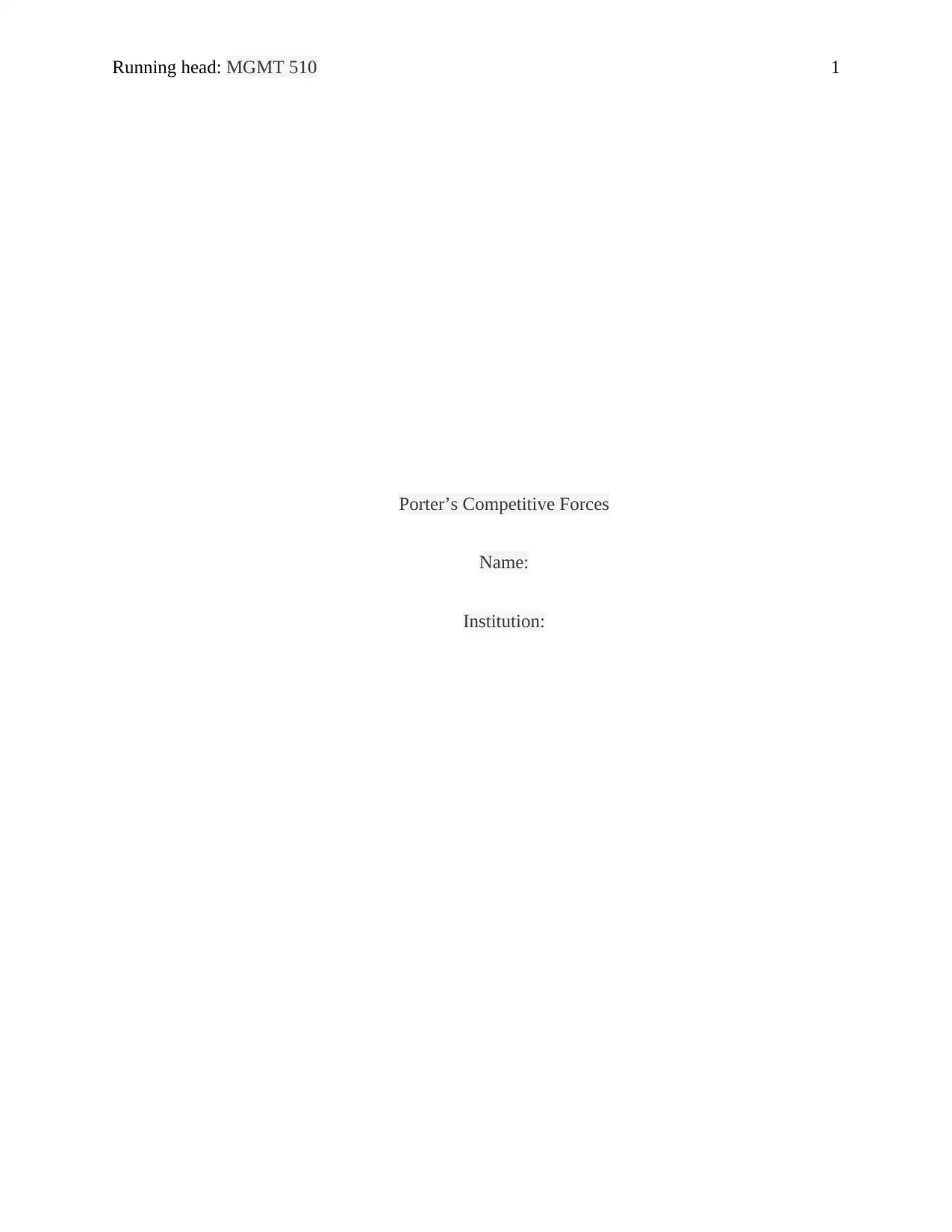
Running head: MGMT 510 1
Porter’s Competitive Forces
Name:
Institution:
Porter’s Competitive Forces
Name:
Institution:
Paraphrase This Document
Need a fresh take? Get an instant paraphrase of this document with our AI Paraphraser
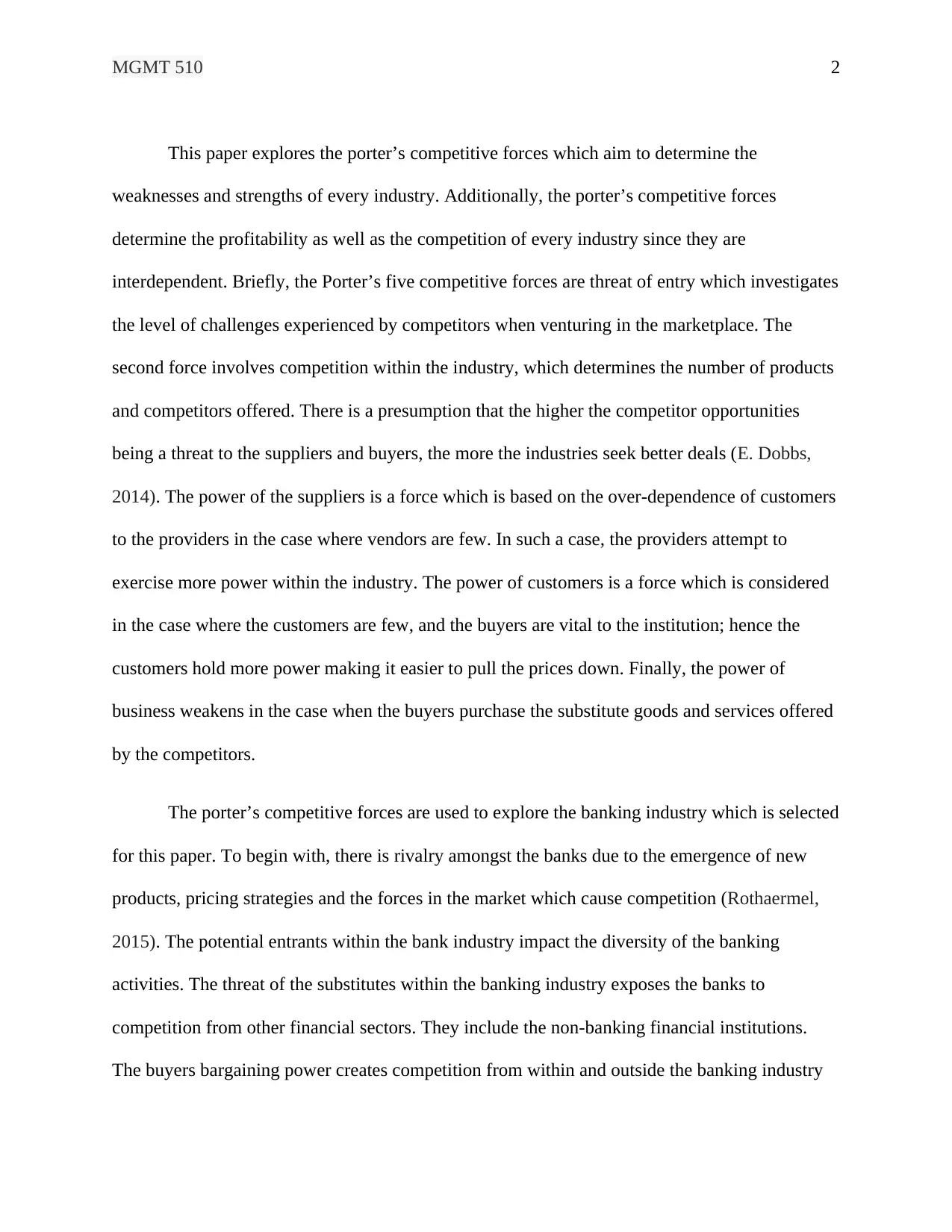
MGMT 510 2
This paper explores the porter’s competitive forces which aim to determine the
weaknesses and strengths of every industry. Additionally, the porter’s competitive forces
determine the profitability as well as the competition of every industry since they are
interdependent. Briefly, the Porter’s five competitive forces are threat of entry which investigates
the level of challenges experienced by competitors when venturing in the marketplace. The
second force involves competition within the industry, which determines the number of products
and competitors offered. There is a presumption that the higher the competitor opportunities
being a threat to the suppliers and buyers, the more the industries seek better deals (E. Dobbs,
2014). The power of the suppliers is a force which is based on the over-dependence of customers
to the providers in the case where vendors are few. In such a case, the providers attempt to
exercise more power within the industry. The power of customers is a force which is considered
in the case where the customers are few, and the buyers are vital to the institution; hence the
customers hold more power making it easier to pull the prices down. Finally, the power of
business weakens in the case when the buyers purchase the substitute goods and services offered
by the competitors.
The porter’s competitive forces are used to explore the banking industry which is selected
for this paper. To begin with, there is rivalry amongst the banks due to the emergence of new
products, pricing strategies and the forces in the market which cause competition (Rothaermel,
2015). The potential entrants within the bank industry impact the diversity of the banking
activities. The threat of the substitutes within the banking industry exposes the banks to
competition from other financial sectors. They include the non-banking financial institutions.
The buyers bargaining power creates competition from within and outside the banking industry
This paper explores the porter’s competitive forces which aim to determine the
weaknesses and strengths of every industry. Additionally, the porter’s competitive forces
determine the profitability as well as the competition of every industry since they are
interdependent. Briefly, the Porter’s five competitive forces are threat of entry which investigates
the level of challenges experienced by competitors when venturing in the marketplace. The
second force involves competition within the industry, which determines the number of products
and competitors offered. There is a presumption that the higher the competitor opportunities
being a threat to the suppliers and buyers, the more the industries seek better deals (E. Dobbs,
2014). The power of the suppliers is a force which is based on the over-dependence of customers
to the providers in the case where vendors are few. In such a case, the providers attempt to
exercise more power within the industry. The power of customers is a force which is considered
in the case where the customers are few, and the buyers are vital to the institution; hence the
customers hold more power making it easier to pull the prices down. Finally, the power of
business weakens in the case when the buyers purchase the substitute goods and services offered
by the competitors.
The porter’s competitive forces are used to explore the banking industry which is selected
for this paper. To begin with, there is rivalry amongst the banks due to the emergence of new
products, pricing strategies and the forces in the market which cause competition (Rothaermel,
2015). The potential entrants within the bank industry impact the diversity of the banking
activities. The threat of the substitutes within the banking industry exposes the banks to
competition from other financial sectors. They include the non-banking financial institutions.
The buyers bargaining power creates competition from within and outside the banking industry
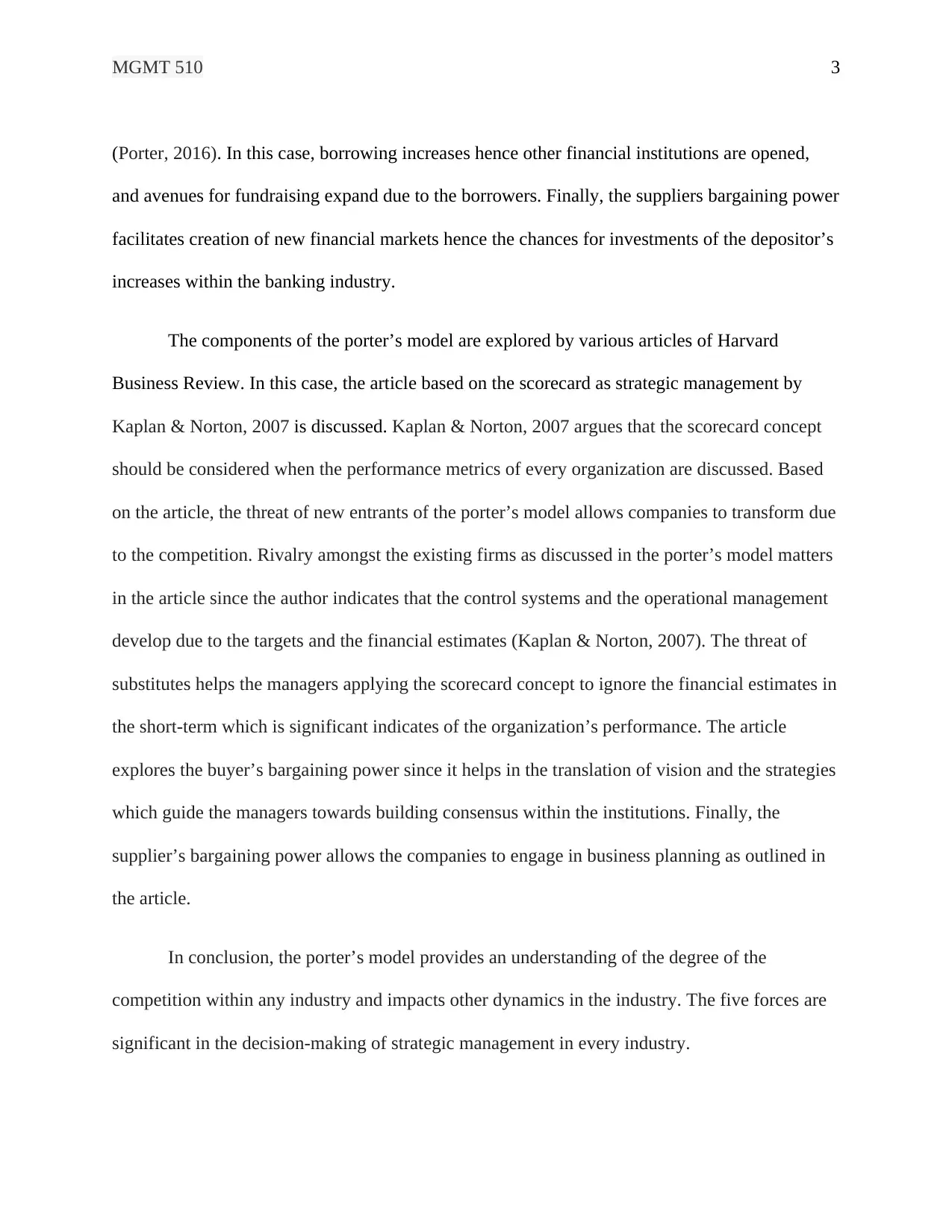
MGMT 510 3
(Porter, 2016). In this case, borrowing increases hence other financial institutions are opened,
and avenues for fundraising expand due to the borrowers. Finally, the suppliers bargaining power
facilitates creation of new financial markets hence the chances for investments of the depositor’s
increases within the banking industry.
The components of the porter’s model are explored by various articles of Harvard
Business Review. In this case, the article based on the scorecard as strategic management by
Kaplan & Norton, 2007 is discussed. Kaplan & Norton, 2007 argues that the scorecard concept
should be considered when the performance metrics of every organization are discussed. Based
on the article, the threat of new entrants of the porter’s model allows companies to transform due
to the competition. Rivalry amongst the existing firms as discussed in the porter’s model matters
in the article since the author indicates that the control systems and the operational management
develop due to the targets and the financial estimates (Kaplan & Norton, 2007). The threat of
substitutes helps the managers applying the scorecard concept to ignore the financial estimates in
the short-term which is significant indicates of the organization’s performance. The article
explores the buyer’s bargaining power since it helps in the translation of vision and the strategies
which guide the managers towards building consensus within the institutions. Finally, the
supplier’s bargaining power allows the companies to engage in business planning as outlined in
the article.
In conclusion, the porter’s model provides an understanding of the degree of the
competition within any industry and impacts other dynamics in the industry. The five forces are
significant in the decision-making of strategic management in every industry.
(Porter, 2016). In this case, borrowing increases hence other financial institutions are opened,
and avenues for fundraising expand due to the borrowers. Finally, the suppliers bargaining power
facilitates creation of new financial markets hence the chances for investments of the depositor’s
increases within the banking industry.
The components of the porter’s model are explored by various articles of Harvard
Business Review. In this case, the article based on the scorecard as strategic management by
Kaplan & Norton, 2007 is discussed. Kaplan & Norton, 2007 argues that the scorecard concept
should be considered when the performance metrics of every organization are discussed. Based
on the article, the threat of new entrants of the porter’s model allows companies to transform due
to the competition. Rivalry amongst the existing firms as discussed in the porter’s model matters
in the article since the author indicates that the control systems and the operational management
develop due to the targets and the financial estimates (Kaplan & Norton, 2007). The threat of
substitutes helps the managers applying the scorecard concept to ignore the financial estimates in
the short-term which is significant indicates of the organization’s performance. The article
explores the buyer’s bargaining power since it helps in the translation of vision and the strategies
which guide the managers towards building consensus within the institutions. Finally, the
supplier’s bargaining power allows the companies to engage in business planning as outlined in
the article.
In conclusion, the porter’s model provides an understanding of the degree of the
competition within any industry and impacts other dynamics in the industry. The five forces are
significant in the decision-making of strategic management in every industry.
⊘ This is a preview!⊘
Do you want full access?
Subscribe today to unlock all pages.

Trusted by 1+ million students worldwide
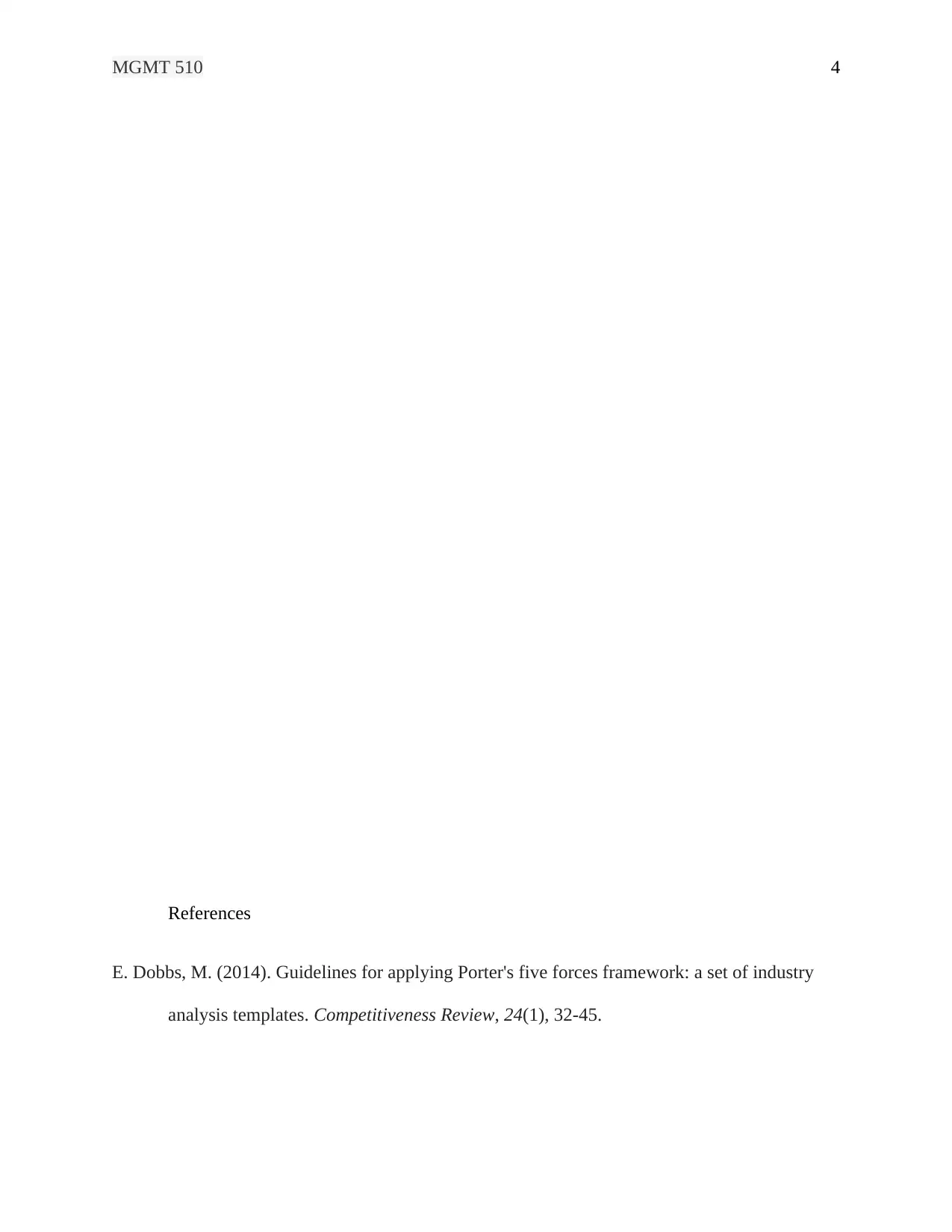
MGMT 510 4
References
E. Dobbs, M. (2014). Guidelines for applying Porter's five forces framework: a set of industry
analysis templates. Competitiveness Review, 24(1), 32-45.
References
E. Dobbs, M. (2014). Guidelines for applying Porter's five forces framework: a set of industry
analysis templates. Competitiveness Review, 24(1), 32-45.
Paraphrase This Document
Need a fresh take? Get an instant paraphrase of this document with our AI Paraphraser
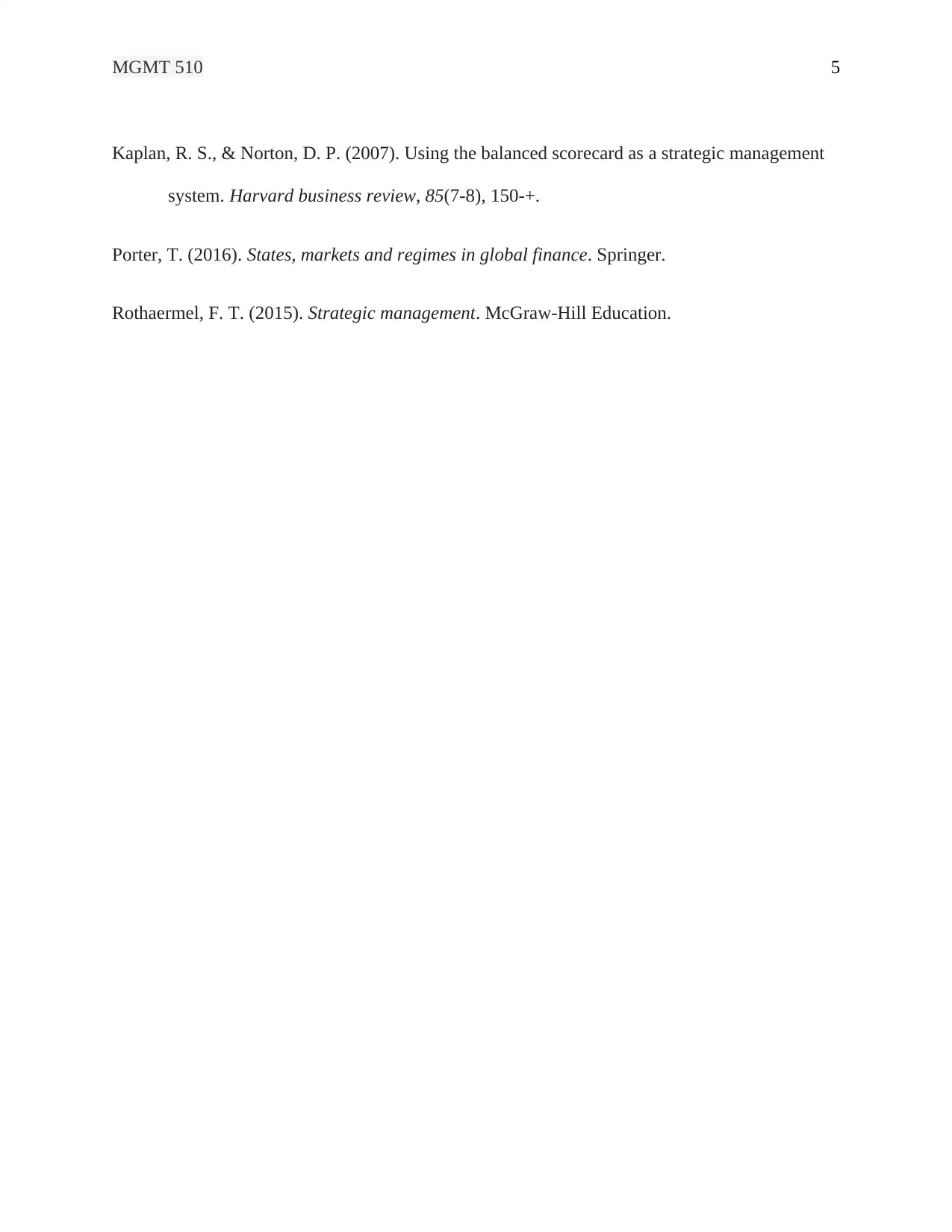
MGMT 510 5
Kaplan, R. S., & Norton, D. P. (2007). Using the balanced scorecard as a strategic management
system. Harvard business review, 85(7-8), 150-+.
Porter, T. (2016). States, markets and regimes in global finance. Springer.
Rothaermel, F. T. (2015). Strategic management. McGraw-Hill Education.
Kaplan, R. S., & Norton, D. P. (2007). Using the balanced scorecard as a strategic management
system. Harvard business review, 85(7-8), 150-+.
Porter, T. (2016). States, markets and regimes in global finance. Springer.
Rothaermel, F. T. (2015). Strategic management. McGraw-Hill Education.
1 out of 5
Related Documents
Your All-in-One AI-Powered Toolkit for Academic Success.
+13062052269
info@desklib.com
Available 24*7 on WhatsApp / Email
![[object Object]](/_next/static/media/star-bottom.7253800d.svg)
Unlock your academic potential
Copyright © 2020–2025 A2Z Services. All Rights Reserved. Developed and managed by ZUCOL.





